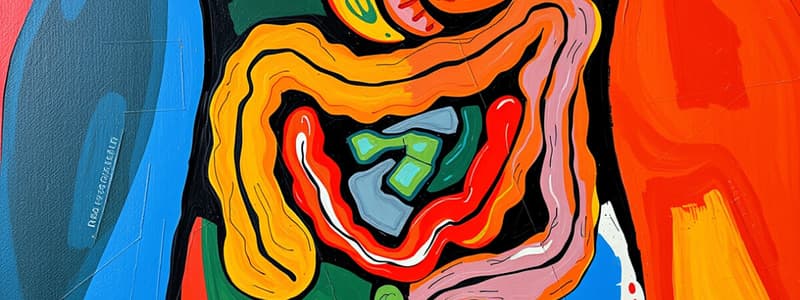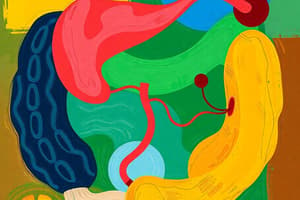Podcast
Questions and Answers
The circular muscles contract, making the lumen of the alimentary canal smaller and squeezing food __________.
The circular muscles contract, making the lumen of the alimentary canal smaller and squeezing food __________.
forwards
The __________ mixes the food with saliva and forms it into a bolus.
The __________ mixes the food with saliva and forms it into a bolus.
tongue
The stomach is a muscular organ that churns and mixes food with __________ juices.
The stomach is a muscular organ that churns and mixes food with __________ juices.
gastric
Most digestion and absorption of nutrients takes place in the __________.
Most digestion and absorption of nutrients takes place in the __________.
The large intestine absorbs water and forms __________.
The large intestine absorbs water and forms __________.
The __________ produces bile, which helps to break down fats.
The __________ produces bile, which helps to break down fats.
The gall bladder stores and releases bile into the __________.
The gall bladder stores and releases bile into the __________.
The pancreas produces __________ that help to digest carbohydrates, proteins, and fats.
The pancreas produces __________ that help to digest carbohydrates, proteins, and fats.
The process of breaking down food into smaller molecules that can be absorbed is called __________.
The process of breaking down food into smaller molecules that can be absorbed is called __________.
The process of taking in nutrients from digested food is known as __________.
The process of taking in nutrients from digested food is known as __________.
Flashcards are hidden until you start studying
Study Notes
Digestive Process
- Circular muscles contract to reduce the lumen size of the alimentary canal, pushing food forward.
- Longitudinal muscles relax, allowing the alimentary canal walls to expand.
The Mouth
- Ingestion occurs using teeth, lips, and tongue to break food into smaller pieces.
- Tongue mixes food with saliva, forming a bolus for swallowing.
- Saliva, produced by salivary glands, aids in moistening food and initiating digestion.
Relevant Organs
- Major organs involved in digestion include:
- Nasal cavity
- Tongue
- Salivary glands and ducts
- Trachea
- Oesophagus
- Stomach
- Pancreas
- Small intestine (duodenum and ileum)
- Large intestine (colon, rectum, anus)
- Liver
- Gall bladder
- Bile duct
- Pancreatic duct
- Caecum
- Appendix
Organ Functions
- Stomach: Churns and mixes food with gastric juices.
- Small Intestine: Primary site for digestion and nutrient absorption.
- Large Intestine: Absorbs water and forms faeces.
- Liver: Produces bile for fat breakdown.
- Gall Bladder: Stores and releases bile into the small intestine.
- Pancreas: Produces enzymes for digesting carbohydrates, proteins, and fats.
- Salivary Glands: Produce saliva that begins digestion.
Digestive Processes
- Digestion: Breaks down food into smaller absorbable molecules.
- Absorption: Nutrients from digested food enter the body.
- Egestion: Eliminates waste products from the body.
Studying That Suits You
Use AI to generate personalized quizzes and flashcards to suit your learning preferences.



